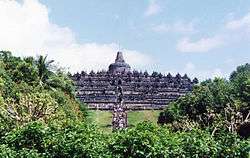Aliran kepercayaan
Aliran Kepercayaan[note 1] is an official cover term for various, partly syncretic forms of mysticism in Indonesia.[2] It includes kebatinan, kejiwan, and kerohanian.[2] In the Indonesian language, it is also used for local religions and beliefs in other parts of the world.
| Part of a series on |
| Religion of Java |
|---|
 |
|
Early religiosity |
|
Hinduism |
|
Kebatinan |
|
Christianity
|
Characteristics
Kebatinan can be described as an amalgam of animist, Hindu-Buddhist, and Islamic (especially Sufi) mystical elements that combine to form Javanese mysticism. According to Caldarola, kepercayaan "is not an apt characterization of what the mystical groups have in common".[2] The US State Department's states:
Sizeable populations in Java, Kalimantan, and Papua practice animism and other types of traditional belief systems termed "Aliran Kepercayaan." Many of those who practice Kepercayaan describe it as more of a meditation-based spiritual path than a religion. Some animists combine their beliefs with one of the government-recognized religions.[3]
Recognition
As a body of belief, kebatinan is officially recognized in the 1945 Indonesian constitution; however, to avoid recognizing it as a formal religion, it is administered by the Department of Education and Culture rather than by the Department of Religious Affairs. The Indonesian Government recognizes the right to follow Aliran Kepercayaan, as long as its practitioners do not upset the public order or offend the sensitivities of the followers of the major religions.
Aliran Kepercayaan has recently been rejected by the United Development Party [PPP] heterodoxy.
Indonesia's Constitutional Court in November 2017 ruled that followers of faiths outside the 6 recognized are allowed to state so on their national identity cards, as a 7th category aliran kepercayaan including Marapu religion, the Parmalim followers of Ugamo Bangsa Batak religion, and id:Sapta Darma, something that has never happened in Indonesia.[4] Nevertheless, it is unclear if Papuan religions are recognized at this point.
Notes
References
- Indonesia: East Java native religion called Aliran Kepercayaan or Kepercayaan Kepada Tuhan Yang Maha Esa, aka Pangistu; its status and treatment of its members by Muslim fundamentalists (2003-June 2004)
- Caldarola 1982, p. 539, note 30.
- "International Religious Freedom Report 2005 (Indonesia)"
- http://jakartaglobe.id/news/indonesias-constitutional-court-says-yes-indigenous-faiths/
Sources
- Caldarola, Carlo (1982), Religion and Societies: Asia and the Middle East, Walter de GruyterCS1 maint: ref=harv (link)
- Ensiklopedi Kepercayaan terhadap Tuhan Yang Maha Esa (in Indonesian) (4th ed.). Jakarta: Direktorat Jenderal Nilai Budaya, Seni dan Film; Direktorat Kepercayaan Terhadap Tuhan Yang Maha Esa. 2010 [2003]. ISBN 978-979-16071-1-7.